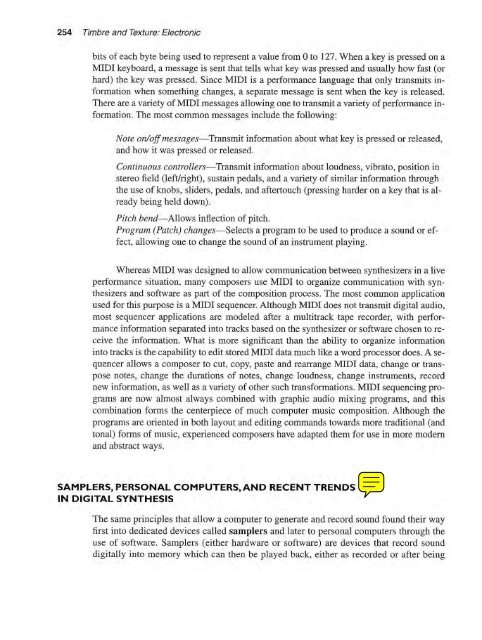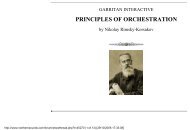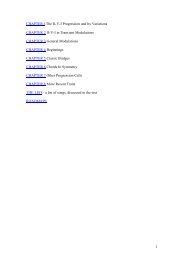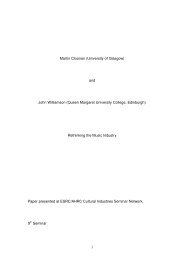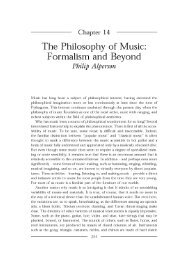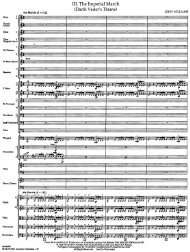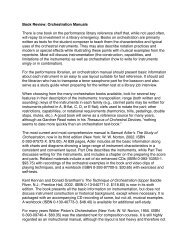TWENTIETH- - Synapse Music
TWENTIETH- - Synapse Music
TWENTIETH- - Synapse Music
Create successful ePaper yourself
Turn your PDF publications into a flip-book with our unique Google optimized e-Paper software.
254 Timbre and Texture: Electronic<br />
bits of each byte being used to represent a value from 0 to 127. When a key is pressed on a<br />
MIDI keyboard, a message is sent that tells what key was pressed and usually how fast (or<br />
hard) the key was pressed. Since MIDI is a performance language that only transmits information<br />
when something changes, a separate message is sent when the key is released.<br />
There are a variety of MIDI messages allowing one to transmit a variety of performance information.<br />
111e most common messages include the following:<br />
NOle on/off messages- Transmit information about what key is pressed or released,<br />
and how it was pressed or released.<br />
Continuous controllers- Transmit information about loudness, vibrato, position in<br />
stereo field (left/right), sustain pedals, and a variety of similar information through<br />
the use of knobs, sliders, pedals, and aftertouch (pressing harder on a key that is already<br />
being held down).<br />
Pilch bend-Allows inflection of pitch.<br />
Program (Patch) changes-Selects a program to be used to produce a sound or effect,<br />
allowing one to change the sound of an instrument playing.<br />
Whereas MIDI was designed to allow communication between synthesizers in a live<br />
pertormance situation, many composers use MIDI to organize communication with synthesizers<br />
and software as part of the composition process. The most common application<br />
used for this purpose is a MIDI sequencer. Although MIDI does not transmit digital audio,<br />
most sequencer applications are modeled after a multitrack tape recorder, with performance<br />
information separated into tracks based on the synthesizer or software chosen to receive<br />
the jnformation. What is more significant than the ability to organize information<br />
into tracks is the capability to edit stored MIDI data much like a word processor does. A sequencer<br />
allows a composer to cut, copy, paste and rearrange MIDI data, change or transpose<br />
notes, change the durations of notes, change loudness, change instruments, record<br />
new information, as well as a variety of other such transformations. MIDI sequencing programs<br />
are now almost always combined with graphic audio mixing programs, and this<br />
combination forms the centerpiece of much computer music composition. Although the<br />
programs are oriented in both layout and editing commands toward" more traditional (and<br />
tonal) forms of music, experienced composers have adapted them for use in more modern<br />
and abstract ways.<br />
SAMPLERS, PERSONAL COMPUTERS,AND RECENT TRENDS<br />
IN DIGITAL SYNTHESIS<br />
The same principles that all ow a computer to generate and record sound found their way<br />
first into dedicated devices called samplers and later to personal computers through the<br />
use of software. Samplers (either hardware or software) are devices that record sound<br />
digitally into memory which can then be played back, either as recorded or after being


